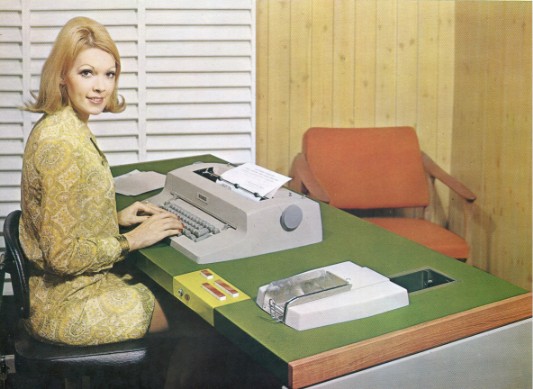SUSIE (Stock Updating and Sales Invoicing Electronically)
SADIE was subsequently developed into a more general-purpose system known as SUSIE. At first glance, the new system looked very similar to SADIE, but the major difference between the two machines was that SUSIE was a stored-program computer with the program held on an internal magnetic drum store rather than hard-wired into the machine. Much of the CPU logic of SADIE was reused in SUSIE
Standard programs could now be developed by BCL that required only minor modification for different customers, and minor changes to the applications could be made in the field.
Alongside the main typewriter desk was a unit with a paper-tape punch and reader and an edge-punched card reader. SUSIE would be used for similar tasks to those performed using SADIE, but SUSIE was capable of running four different programs with the operator selecting one using a set of push buttons next to the keyboard. The edge-punched card reader allowed the customer details such as account number and invoice and delivery addresses to be read from a customer-specific punched card rather than being typed in manually. The application could also punch the invoice details to paper tape as they were being entered by the operator and the tapes produced at the end of the month sent to a bureau for customer statement production and further analysis.
As well as storing the application programs, there was sufficient space on the magnetic drum to maintain a product stock file. BCL promotional material at the time suggests a limit of over a hundred different product lines including part number, unit price and current stock level. SUSIE was given paper-tape and edge-punched card stations not solely to satisfy a particular customer requirement, but also to ensure that SUSIE fell within the Ministry of Technology’s standard definition of a computer and thus to enable purchasers to claim 20% tax relief on their investment.
Spectacular Growth By 1967, the group had opened 13 sales offices throughout the UK and the Republic of Ireland and had sold over 700 systems. Two years later six more sales offices had been added. SADIE and SUSIE systems typically sold for between £2,750 and 6,750 and SUSIE systems between £7,000 and £30,000. Later in 1969, Bill Gannon described the early says of BCL saying ‘There was virtually no competition for this type of machine when we started serious production'.
Multi-SUSIE was launched in 1969 at the annual Business Efficiency Exhibition.
Individual SUSIE workstations could now be connected to a central machine with a larger drum store that acted as the common program and data store for each SUSIE user. Extra instructions were added to the SUSIE order code to manage access to this shared resource. The larger drum also allowed eight application programs to be stored which were all available to each user. The new multi-user system proved to be very successful commercially with over 300 systems sold by 1972.

